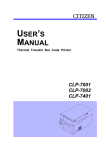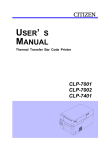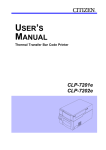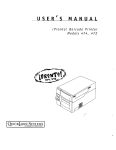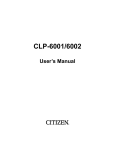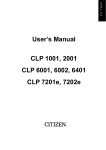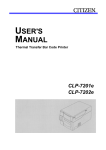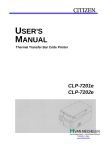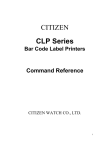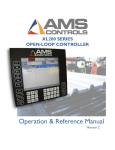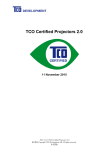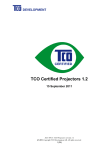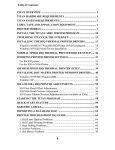Download Citizen CLP-7001 User`s manual
Transcript
USER’S MANUAL Thermal Transfer Bar Code Printer CLP-7001 CLP-7002 CLP-7401 FCC COMPLIANCE STATEMENT FOR AMERICAN USERS This equipment has been tested and found to comply with the limits for a Class A digital device, pursuant to Part 15 of the FCC Rules. These limits are designed to provide reasonable protection against harmful interference when the equipment is operated in a commercial environment. This equipment generates, uses, and can radiate radio frequency energy and, if not installed and used in accordance with the instruction manual, may cause harmful interference to radio communications. Operation of this equipment in a residential area is likely to cause harmful interference in which case the user will be required to correct the interference at his own expense. "DESIGNED AND MANUFACTURED TO BE EQUIVALENT TO EUROPEAN STANDARD FOR ITE, EN60950." 1 EMI COMPLIANCE STATEMENT FOR CANADIAN USERS This equipment generates and uses radio frequency energy and if not installed and used properly, that is, in strict accordance with the manufacturer's instructions, may cause interference to radio and television reception. This digital apparatus does not exceed the Class A limits for radio noise emissions from digital apparatus set out in the Radio Interference Regulations of the Canadian Department of Communications. This equipment is designed to provide reasonable protection against such interference in a residential installation. However, there is no guarantee that interference will not occur in a particular installation. If this equipment does cause interference to radio or television reception, which can be determined by turning the equipment off and on, the user is encouraged to try to correct the interference by one or more of the following measures: • Reorient or relocate the receiving antenna. • Increase the separation between the equipment and receiver. • Connect the equipment into an outlet on a circuit different from that to which the receiver is connected. • Consult the dealer or an experienced radio/TV technician for help. CAUTION: Use shielded cables to connect this device to computers. Any changes or modifications not expressly approved by the grantee of this device could void the user's authority to operate the equipment. ETAT DE CONFORMITE EMI A L'USAGE DES UTILISATEURS CANADIENS Cet équipment produit et utilise l'énergie à radiofréquences et s'il n'est pas installé et utilisé correctment, c'esst à dire en accord strict avec les instructions du fabricant, il risque de provoquer des intérferences avec la réception de la radio et de la télévision. Le présent appareil numérique n'émet pas de bruite radioélectriques dépassant les limites applicables aux appareils numériques de la classe A prescrites dans le Réglement sur le brouillage radioélectrique édicté par le ministère des Communications du Canada. Cet équipment est conçu pour fournir une protection satisfaisante contre de telles interférences dans une installation résidentielle. Cependant, il n'y a pas de garantie contre les interférences avec les réceptions radio ou télévison, provoquées par la mise en et hors circuit de l'équipment; aussi, il est demandé a l'utilisateur d'essayer de corriger l'interférence par l'une ou plus des mesures suivantes: • Réorienter l'antenne de réception. • Installer l'ordinateur autre part, par égard pour le récepteur. • Brancher l'ordinateur dans une prise de courant différente de façon à ce que l'ordinateur et le récepteur soient branchés sur des circuits différents. 2 Important Safety Instructions 1. Read all of these instructions and save them for later reference. 2. Follow all warnings and instructions marked on the product. 3. Unplug this product from the wall outlet before cleaning. Do not use liquid or aerosol cleaners. Use a damp cloth for cleaning. 4. Do not use this product near water. 5. Do not place this product on an unstable cart, stand or table. The product may fall, causing serious damage to the product. 6. Slots and openings on the cabinet and the back or bottom are provided for ventilation. To ensure reliable operation of the product and to protect it from overheating, do not block or cover these openings. The openings should never be blocked by placing the product on a bed, sofa, rug or other similar surface. This product should never be placed near or over a radiator or heat register. This product should not be placed in a built-in installation unless proper ventilation is provided. 7. This product should be operated from the type of power source indicated on the marking label. If you are not sure of the type of power available, consult your dealer or local power company. 8. This product is equipped with a three-pronged plug, a plug having a third (grounding) pin. This plug will only fit into a grounding-type power outlet. This is a safety feature. If you are unable to insert the plug into the outlet, contact your electrician to replace your obsolete outlet. Do not defeat the safety purpose of the grounding-type plug. 9. Do not allow anything to rest on the power cord. Do not locate this product where the cord will be walked on. 10. If an extension cord is used with this product, make sure that the total of the ampere ratings on the products plugged into the extension cord do not exceed the extension cord ampere rating. Also, make sure that the total of all products plugged into the wall outlet does not exceed 15 amperes for 120V outlet and 7.5 amperes for 220V −240V outlet. 11. Never push objects of any kind into this product through cabinet slots as they may touch dangerous voltage points or short out parts that could result in a risk of fire or electric shock. Never spill liquid of any kind on the product. 12. Except as explained elsewhere in this manual, don't attempt to service this product yourself. Opening and removing those covers that are marked "Do Not Remove" may expose you to dangerous voltage points or other risks. Refer all servicing on those compartments to service personnel. 13. The mains plug on this equipment must be used to disconnect mains power. Please ensure that the socket outlet is installed near the equipment and shall be easily accessible. 14. Unplug this product from the wall outlet and refer servicing to qualified service personnel under the following conditions: A. When the power cord or plug is damaged or frayed. B. If liquid has been spilled into the prod uct. C. If the product has been exposed to rain or water. D. If the product does not operate normally when the operating instructions are followed. Adjust only those controls that are covered by the operating instructions since improper adjustment of other controls may result in damage and will often require extensive work by a qualified technician to restore the product to normal operation. E. If the product has been dropped or the cabinet has been damaged. F. If the product exhibits a distinct change in performance, indicating a need for service. 3 Notice 1. Before use, be sure to read this manual. And keep it handy for reference when needed. 2. The contents of this manual may change without prior notice. 3. Reproduction, transfer, or transmission of the contents of this manual without prior consent is strictly prohibited. 4. We are not liable for any damage resulting from the use of the information contained herein, regardless of errors, omissions, or misprints. 5. We are not liable for any problems resulting from the use of optional products and consumable supplies other than the designated products contained herein. 6. Do not handle, disassemble or repair the parts other than those specified in this manual. 7. We are not liable for any damage caused by user's erroneous use of the printer and inadequate environment. 8. Data residing in the printer is temporary. Therefore, all data will be lost if power is lost. We are not liable for any damage or loss of profits caused by data loss due to failures, repairs, inspections, etc. 9. Please contact us if there are any mistakes or ambiguities within this manual. 10. If there are missing or incorrectly collated pages in this manual, contact us to obtain a new manual. 4 SAFETY INSTRUCTIONS must be strictly observed ! To prevent personal injury or property damage, the following shall be strictly observed. The degree of possible injury and damage due to incorrect use or improperly following instructions is described below. WARNING Indicates a situation which, if not observed and handled properly, could result in death or serious injury. CAUTION Indicates a situation which, if not observed and handled properly, could result in injury. This is a mark to call attention to the reader. 5 WARNING T Never perform the following. If not avoided, these may cause damage or trouble to the printer or cause the printer to overheat and release smoke and cause burns or an electrical shock. If the printer is damaged or is malfunctioning, be sure to turn the power off immediately and remove the power cord from the outlet, then consult our service personnel. • Do not jolt or impact to the printer by stepping on, dropping or hitting the printer. • Do not place the printer in a poorly ventilated area, or shut off the air vent of the printer. • Do not place the printer where chemical reactions occur, such as in laboratories or where air is mixed with salt or gas. • Do not use a power voltage or frequency other than those specified. • Do not plug/unplug the power cord or attach/detach the interface cable by simply grabbing the power cord or interface cable. Do not pull or carry the printer when the tension of the power cord or interface cable is increased. • Do not drop or put foreign matter such as clips and pins into the printer. This may cause problems. • Do not plug the power cord into an outlet with many loads. • Do not spill drinks such as tea, coffee and juice on the printer or spray insecticide on the printer. If drink or water is spilled, first be sure to turn the power off and remove the power cord from the outlet, then consult our service personnel. • Do not disassemble or modify the printer. T Discard or safely store the plastic packing ba g. This bag should be kept away from children. If the bag is pulled over a child’s head, it may cause suffocation. 6 General Precautions 1. Prior to operation, read the safety instructions carefully and observe them. 2. Do not drop or put foreign matter such as clips and pins into the printer. This may cause problems. 3. Be careful when moving or carrying the printer. Dropping the printer may cause injury or property damage. 4. Make sure if you open the top cover, it is opened all the way. If only partially open, the cover could slam shut, possibly causing injury. 5. When the cover is open, be careful of the corners of the cover. They could cause injury. 6. Do not open the printer during printing. 7. When cleaning the surface of the printer case, do not use the cloth that is soaked in thinner, trichloroethylene, benzine, ketone or similar chemicals. 8. Do not use the printer where there is a lot of oil, iron particles, or dust. 9. Do not spill liquids or spray insecticide on the printer. 10. Do not jolt or impact to the printer by stepping on, dropping or hitting the printer. 11. Operate the control panel properly. A careless, rough handling may cause problems or malfunction. Do not use such sharp-edged tool as a ballpoint pen for operation. 12. Be careful of the edges of the plates so injury or property damage is possible. 13. If a problem occurs during printing, stop the printer immediately and unplug the power cord from the outlet. 14. When printer trouble occurs, do not try to dissemble it. Instead, consult our service personnel. 7 Precautions When Installing the Printer 1. Prior to operation, read the safety instructions carefully and observe them. 2. Do not use or store the printer near fire, excessive moisture, in direct sunlight, near an air conditioner or heater or other source of unusually high or low temperature or humidity or excessive dust. 3. Do not place the printer where chemical reactions occur, such as in a laboratory. 4. Do not place the printer where air is mixed with salt or gas. 5. The printer must sit on a firm, level surface where there is ample ventilation. allow the printer's air vent to be blocked by a wall or other object. 6. Do not put anything on the top of printer. 7. Do not place the printer near a radio or television, and do not use the same wall outlet for the printer and radio or television. Radio or television reception could be adversely affected. 8. Do not use a power voltage or frequency other than those specified. 9. Do not put anything on the power cord or step on it. 10. Do not drag or carry the printer with the power cord or inter face cable. 11. Avoid plugging the power cord into an outlet with many loads. 12. Do not bundle the power cord when inserting the plug. 13. Always grip the plug housing, not the cord, to plug/unplug the power cord. Never 14. Make certain the power is turned off before connecting/disconnecting the interface cable. 15. Avoid lengthening the signal cable or connecting it to any noise-producing device. If it is unavoidable, use the shielded cable or twisted pair for each signal. 16. Place the printer near the outlet where the power cord can be unplugged easily to shut off power. 17. Use the AC outlet that accepts a three-pronged plug. Otherwise, static electricity may be generated and there will be danger of electric shock. 8 Contents Before Operation FCC COMPLIANCE STATEMENT FOR AMERICAN USERS ...................................... 1 EMI COMPLIANCE STATEMENT FOR CANADIAN USERS ....................................... 2 Important Safety .......................................................................................................... 3 Notice .......................................................................................................................... 4 Safety Instructions........................................................................................................ 5 Warning ....................................................................................................................... 6 General Precautions..................................................................................................... 7 Precautions When Installing the Printer........................................................................ 8 Contents ...................................................................................................................... 9 Main Features ............................................................................................................ 11 Model Description ...................................................................................................... 12 Chapter 1 Setup 1 2 3 4 Confirmation of Carton Contents ................................................................. 14 Part Names and Functions .......................................................................... 15 Connection to Power .................................................................................... 18 Connection to a Computer........................................................................... 19 Chapter 2 Printer Operation 1 2 3 4 5 6 Power On/Off ................................................................................................ 21 Normal Operating Mode ............................................................................... 23 Printer Setup Mode ...................................................................................... 24 Self-Test Mode.............................................................................................. 26 System Maintenance Mode .......................................................................... 28 Returning to Factory Setting........................................................................ 31 9 Contents Chapter 3 Paper and Ribbon 1 2 3 4 5 6 Kinds of Paper ............................................................................................... 34 Media Handling (When Using Front Sensors) ................................................. 35 Media Handling (When Using Adjustable Sensor) .......................................... 36 Paper Setting ................................................................................................. 37 Kinds of Ribbon.............................................................................................. 39 Ribbon Setting ............................................................................................... 40 Chapter 4 Printer Adjustments 1 2 3 4 5 Using Paper Other Than the Recommended (Head Offset Adjustments) 43 Using Narrow Paper (Head Pressure Adjustments).................................... 44 Using Narrow Ribbon (Ribbon Tension Adjustments)................................. 45 Adjustable Sensor (For CLP-7001/7401) ..................................................... 46 Cleaning......................................................................................................... 47 Chapter 5 Troubleshooting 1 2 3 4 5 6 Error Messages ............................................................................................. 49 Power Troubleshooting.................................................................................. 53 Paper Feed Troubleshooting ........................................................................ 54 Ribbon Feed Troubleshooting....................................................................... 55 Print Troubleshooting .................................................................................... 56 Interface Troubleshooting .............................................................................. 57 Appendixes 1 Options .......................................................................................................... 60 2 Specifications................................................................................................. 62 10 Main Features High-speed, high-quality printing This printer adopts both a direct-thermal and thermal-transfer printing system with the line thermal head and its unique control IC enables high-speed and high-quality printing. Precision printing for additional value: 400dpi New technologies such as the newly-developed 400dpi head in the CLP-7401, unique control IC and optimized driving technology for high-resolution printing are all available on Citizen label printers creating labels that are crisp, clear, easy-to-read and scan. Also, thanks to the additional front (label) sensors, an amazingly high level of accuracy can be achieved; small sized labels, miniature bar codes and small fonts are produced on demand and in the correct position leading to a reduction in cost, lead time and stock holding. Powerful control language A powerful yet simple to use control language is standard to all of Citizen’s label printers allowing easy design of labels and bar codes. Alternatively, Citizen provides printer drivers for popular operating systems such as Windows™. Easy operation Thanks to the clam-shell mechanism, labels, media and ribbons are loaded easily and maintenance such as head cleaning is carried out smoothly. Parallel and serial ports as the standard The parallel port (Centronics) in addition to the serial port is provided as the standard to enable high-speed data transmitting and industry compatible connectivity. Adjustable media sensor The moveable media detection sensor, standard on the CLP-7001 and CLP-7401 allows irregularly cut labels and tags to be used with ease. The sensors can also detect black registration marks that are not at the edge of the media. Trademark Acknowledgement: Windows: Microsoft Corporation 11 Model Description This manual is prepared for the three models, CLP-7001, CLP-7002 and CLP-7401. The main different points on the specifications among the three are shown below. Model Print resolution Printing speed Adjustable sensor CLP-7001 203dpi 2−7 IPS Standard CLP-7002 203dpi 2−6 IPS Optional CLP-7401 400dpi 1−4 IPS Standard 12 Chapter 1 Setup 1 Confirmation of Carton Contents 2 Part Names and Functions 3 Connection to Power 4 Connection to a Computer 1 Chapter 1 Setup 1 Confirmation of Carton Contents Check that the following accessories are included with the printer in the cart on. Power cord Roll holder Roll guide Paper core Ink ribbon User’s manual Cleaning pen Printer Label paper • The empty carton and packing materials should be stored for future shipping of the printer. CAUTION • Be careful when moving or carrying the printer and when taking the printer out of the carton. The printer may cause injury or property damage if dropped. Be sure to grip the printer housing tightly when taking it out of the carton. Do not grip the printer by the foam packing material which may break, causing the printer to drop. 2 Chapter 1 Setup 2 Part Names and Functions Front view 8 1 3 12 6 4 5 7 9 10 11 2 1 Cover Opens to allow loading of the paper and ribbon. 2 Control panel To set the printer settings. (See Chapter 2.) 3 Ribbon holder To attach the ribbon. (See Chapter 3.) 4 Ribbon winder To wind the ribbon after print. (See Chapter 3.) 8 Open lever To swing the print head out of the way when loading the paper or cleaning the print head. (See Chapter 3.) 9 Open guide Holds down the paper. The movable sensor inside this (when the model is an adjustable sensor type) detects the paper position. (See Chapter 3.) 10 5 Roll holder Holds the roll of paper. 6 Roll guide Guides the roll of paper. This is adjusted according to the width of the paper. (See Chapter 3.) 7 Paper holder Holds the roll holder. (See Chapter 3.) 3 Open guide lever Pressing this opens the open guide to replace the paper. (See Chapter 3.) 11 Front sensors Detect the label and tag paper position. (See Chapter 3.) 12 Offset verification window Allows you to check the optimum position of the print head. (See Chapter 4.) Chapter 1 Setup 2 Part Names and Functions Rear view 3 2 5 4 1 1 Serial interface connector To connect the serial interface cable. 4 Power inlet To connect the power cord. 2 Parallel interface connector To connect the parallel interface cable. 5 PCMCIA memory card cover To protect the PCMCIA memory card from exposure to dust and foreign matter. To install a PCMCIA memory card, first unhook this cover, then slide it out. (See Appendixes.) 3 Power switch To turn on or off the power. (See Chapter 2.) CAUTION • When opening the cover, open it all the way. If only part way open, the cover could slam shut, possibly causing injury. • Be careful of the edge of the cover when the cover is opened. It may cause injury or property damage. • Be careful of the edges of the plates so injury or property damage is possible. 4 Chapter 1 Setup 2 Part Names and Functions Control panel 1 6 2 7 8 5 4 3 5 Stop key Stops the printer operating. 1 LCD Displays the current printer status, configuration settings, or an error message. 6 Paper gap adjustment control To adjust the paper gap sensor sensit ivity. 2 LEDs One LED is the power indicator and the other is the error indicator. 7 Black line adjustment control To adjust the black line sensor sensitivity. 3 Pause key Temporarily pauses printing. 8 LCD contrast adjustment control To adjust the LCD contrast. 4 Feed key Feeds the paper. 17 Chapter 1 Setup 3 Connection to Power 1. Check that the power switch on the printer is turned OFF. 2. Connect the connector of the power cord to the power inlet on the printer. 3. Insert the plug of the power cord in the AC outlet. AC outlet Power switch Power inlet CAUTION • Use an AC outlet that accepts a three-pronged plug. Otherwise, static electricity may be generated and there will be danger of electric shock. 18 Chapter 1 4 Connection to a Computer An interface cable is necessary to connect the printer to a computer. To connect the cable, proceed as follows. 1. Turn off both power switches of the printer and the computer. 2. Connect the connector of one end of the interface cable to the interface connector at the lower side of the printer and secure it with screws. 3. Connect the connector of the other end of the interface cable to the interface connector on the computer and secure it with screws. Parallel interface cable Serial interface cable 19 Setup Chapter 2 PrinterOparetion Chapter 2 Printer Operation 1 Power On/Off 2 Normal Operating Mode 3 Printer Setup Mode 4 Self-Test Mode 5 System Maintenance Mode 6 Returning to Factory Setting 18 2 Chapter 2 PrinterOparetion 1 Power On/Off Turning on the power 1. Turn on the power switch on the back of the printer. 2. The green LED power indicator goes on. Check that the LCD screen displays ‘ON LINE.’ When displaying an error message When operating normally When displaying no message Contrast adjustment control 19 Turn the LCD contrast adjustment control with a small Phillips head screwdriver. Chapter 2 PrinterOparetion 1 Power On/Off Turning off the power 1. Turn off the power switch on the back of the printer. 2. The green LED power indicator goes off and any messag e on the LCD screen disappears. 20 Chapter 2 PrinterOparetion 2 Normal Operating Mode When the power is turned on, the printer enters normal operating mode. The control keys function as follows: Stop key (STOP) With this key, the operator can stop and cancel the current print job. Pressing the Stop key during printing stops the printing immediately. Pressing the Stop key again cancels the print job. Feed key (FEED) Advance to the top of the next label. When using continuous paper, make sure the Sensor selection is set to ContinuP or a Paper error will result. Pause key (PAUSE) Temporarily pauses printing. ‘Pause’ is displayed on the LCD screen. If pressed during printing, printing will stop after the current label is printed. Press the Pause key again to resume printing. 21 Chapter 2 PrinterOparetion 3 Printer Setup Mode In this mode, the print mode, optional equipment ON/OFF and sensor selections are set up. Control keys function in the following. The printer configuration settings are stored in memory so they are maintained even after the power is turned off. Returns to normal operating mode. Pressing these keys simultaneously places the printer into printer setup mode. Selects the mode item. Selects the mode. Example Changing the paper gap sensor to the black line sensor 1. First check the printer goes ON LINE, then press and hold the Pause key and then press the Feed key and release both keys. 2. Change the print mode (direct-thermal or thermal transfer printing) to the sensor selection with the Pause key. 22 Chapter 2 PrinterOparetion 3 Printer Setup Mode 3. Change the paper gap sensor to the black line sensor with the Feed key. 4. Return to normal operating mode with the Stop k ey. Indication Mode item Printing mode Peeling sensor Auto-cutter Tearing Sensor selection Interpreter ∗ ∗ Normally ‘INTP STD’ (interpreter standard) is used. See the Command Reference for details. 23 Chapter 2 PrinterOparetion 4 Self-Test Mode In this mode, self-test printing is performed. With this test printing, you can check the current printer configuration settings and print quality. After loading the paper and ribbon, operate the printer as follows: 1. Press and hold the Feed key while turning the printer on. When label paper is used: Hold down the Feed key for two (2) seconds and the printer will feed the paper and print samples 1 and 2 and stop. When continuous paper is used: Hold down the Feed key for four (4) seconds and the printer will feed the paper and print samples 1 and 2 and stop. Sample 1 ROM version No. Date and time ROM checksum RAM check Communication setting Print mode Media sensor voltage Head rank and resistance value Peeling sensor Auto-cutter Ribbon sensor Total travel distance 24 Chapter 2 PrinterOparetion 4 Self-Test Mode Check the following items in the self-test mode. Check item Cause Dot missing Head disconnected Totally blurred Dust adhered Head offset changed in position Printing energy low Partially blurred Head pressure unbalanced Ribbon wrinkling and slipping Ribbon tension improper Remedy Replace head Clean head(→Section 5 Chapter 4) Adjust head offset (→Section 1 Chapter 4) Adjust printing energy (→Command Reference) Adjust head pressure (→Section 2 Chapter 4) Adjust ribbon tension (→Section 3 Chapter 4) Sample 2 203 dpi Sample 2 400 dpi 2. After self-test printing, the printer enters data dump mode. The communication contents can be checked by printing the communication data in ASCII code. 3. Return to normal operating mode after turning off the power switch. 25 Chapter 2 PrinterOparetion 5 System Maintenance Mode In this mode, the communication, adjustable sensor ON/OFF and sensor voltage selections are set up. The printer configuration settings are stored in memory so they are maintained even after the power is turned off. Control keys function as follows: Return to normal operating mode. Pressing all these keys simultaneously places the printer into system maintenance mode. Selects the mode item. Selects the mode. Example Setting the black line sensor voltage 1. First turn off the power switch, then press and hold down the Pause, Feed and Stop keys simultaneously while turning on the power switch. 2. Change the baud rate to the sensor voltage setting with the Pause key. 26 Chapter 2 PrinterOparetion 5 System Maintenance Mode 3. Change the paper gap sensor voltage to the black line sensor voltage with the Feed key. 4. Return to normal operating mode with the St op key. Indication Mode item Baud rate 9600bps 19200bps Data length 8bits 7bits NativeON NativeOF Command code ∗2 CmndSTD CmndAS4 Adjustable sensor ∗3 AJSensOF AJSensON ∗ ∗∗ ∗ ∗∗ Native ∗1 Voltage setting ∗4 27 Chapter 2 PrinterOparetion 5 System Maintenance Mode ∗1 Native Normally ‘NativeON’ is used. See the Command Reference for details. ∗2 Feed amount See the Command Reference for details. ∗3 Command code Normally ‘CmndSTD’ is used. See the Command Reference for details. ∗4 For adjustable sensor, the voltage setting must be done each time ‘AJSensOF’ is changed to ‘AJSensON, and vice versa. ∗5 Voltage setting In the voltage setting, adjust the paper gap and black line adjustment controls so that the voltages of both ‘PE’ and ‘BL’ displayed on the LCD screen can read 3.0V to 3.3V. 1. Set the liner (glassine paper) only that has been removed from the label. (For th eblack line paper, position the black line so that it does not come to the paper sensor.) 2. Set each level to 3.0V to 3.3V with the controls. Paper gap sensor adjustment control Black line sensor adjustment control 28 Chapter 2 PrinterOparetion 6 Returning to Factory Setting To return the configuration already set in the printer setup mode or system maintenance mode to the factory setting, proceed as follows: Turn off the power switch. Press and hold the Pause, Feed and Stop keys simultaneously while turning on the power switch, and further continue holding down those keys. Press and hold those keys simultaneously while turning on the power switch You hear a ‘Pi’ sound. Further continue holding down those keys When you again hear a ‘Pi’ sound, the operation is completed Factory setting Printer setup mode System maintenance mode Mode item Indication Mode item Indication Printing mode Transfer Baud rate 9600bps Peeling sensor PeelOFF Data length 8bits Auto-cutter CutOFF Native NativeON Tearing TearOFF Feed amount fVirtual Sensor selection Edge Command code CmndSTD Interpreter INTP STD Adjustable sensor AJSensOF Voltage setting PE ∗.∗∗ V 29 Chapter 2 30 PrinterOparetion Chapter 3 Paper and Ribbon Chapter 3 Paper and Ribbon 1 Kinds of Paper 2 Media Handling (When Using Front Sensors) 3 Media Handling (When Using Adjustable Sensor) 4 Paper Setting 5 Kinds of Ribbon 6 Ribbon Setting 33 3 Chapter 3 Paper and Ribbon 1 Kinds of Paper Item Specification Kinds of paper • Thermal-transfer paper • Direct-thermal paper The printer is capable of printing on direct-thermal or thermal-transfer paper. The paper must be high-quality. Otherwise, good print quality and extended print head life cannot be guaranteed. Type of paper • Label paper (continuous, die-cut, fanfold) • Tag paper • Ticket Both in-wound and out-wound paper rolls may be used. Size of paper Paper width Paper thickness 25.4−118 mm 1−4.65 in 0.0635−0.254 mm 0.0025−0.01 in 203 mm 8 in 38−76 mm 1.5−3 in Max. outer diameter of roll paper Paper core inner diameter 34 Chapter 3 2 Media Handling Paper and Ribbon (When Using Front Sensors) The front sensors consist of the transparent-type and reflective-type photosensors and the position of a label or tag is detected as follows: Transparent-type photosensor: Detects paper gap between labels and tag paper notch. Reflective-type photosensor: Detects black line. Note: Check that the adjustable sensor is set to ‘AJSensOF.’ (See Chapter 2.) • Specification of paper For dimensions of paper gap between labels, tag paper (label paper) notch and black line, see figure. Minimum value mm (in) Maximum value mm (in) A Label width 7.62 (0.3) 118.00 (4.65) B Liner width 25.40 (1.0) 118.00 (4.65) C Label left edge position 0 D Label paper gap length 2.54 (0.10) 2539.00 (99.96) E Label length 2.54 (0.10) 2539.00 (99.96) (99.96) 2.54 (0.10) F Label pitch 5.08 (0.20) 2539.00 G Liner thickness 0.06 (0.0025) 0.125 H Paper thickness 0.06 (0.0025) 0.25 (0.01) 8.3 (0.32) 11 (0.43) I Notch right end position J Notch left end position K Notch length 0 L Black line right end position M Black line left end position N Black line width Note: 2.54 (0.10) 15.00 (0.59) 4.7 (0.19) 17.80 (0.70) – 0 3.18 (0.125) 1.5 (0.06) 17.80 (0.70) • Paper having both label paper gap and black line should use the paper -gap sensor. • Fanfold should use the paper-gap sensor. Size of paper Label paper Continuous paper Notch detection Black line detection Label Printable area Label Black line OD value: 1.5 or more Carbon black ink Label Using paper gap adjustment sensor Using paper gap adjustment sensor Using black line adjustment sensor Direction of paper feed Printable area 2.5mm Left margin 104.0mm Printable area 35 (0.0049) (11.5mm) Right margin Chapter 3 Paper and Ribbon 3 Media Handling (When Using Adjustable Sensor) The adjustable sensor is the standard for CLP -7001 and CLP-7401 but it is the optional for CLP7002. Check that the adjustable sensor is set to ‘AJSensON.’ (See Chapter 2.) Minimum value mm (in) Maximum value mm (in) A Label width 25.40 (1.0) 118.00 (4.65) B Liner width 25.40 (1.0) 118.00 (4.65) C Label left edge position 0 2.54 (0.10) D Label paper gap length 2.54 (0.10) 2539.00 (99.96) E Label length 12.70 (0.50) 2539.00 (99.96) F Label pitch 12.70 (0.50) 2539.00 (99.96 G Liner thickness 0.06 (0.0025) 0.125 (0.0049) H Paper thickness 0.06 (0.0025) 0.25 (0.01) I Notch right end position 3.6 (0.14) 60.8 (2.39) J Notch left end position 57.2 (2.25) K Notch length L Black line right end position M Black line left end position N Black line width Note: 0 2.54 (0.10) 17.80 (0.70) 15.00 (0.59) 66.5 (2.62) 51.5 (2.02) (0.125) 17.80 (0.70) 0 3.18 • Paper having both label paper gap and black line should use the paper-gap sensor. • Fanfold should use the paper-gap sensor. Size of paper Label paper Continuous paper Notch detection Black line detection Label Printable area Label Black line OD value: 1.5 or more Carbon black ink Label Using paper gap adjustment sensor Using paper gap adjustment sensor Using black line adjustment sensor Direction of paper feed Printable area 2.5mm Left margin 104.0mm Printable area 36 (11.5mm) Right margin Chapter 3 Paper and Ribbon 4 Paper Setting The printer is designed for easy loading of paper. Open the printer cover and set the paper as follows: 1. Push down the open lever to open the print head. 2. Push down the open guide lever to lift the open guide up. 3. Attach the roll guide to the roll holder and insert this in the hole of the roll paper. Set the roll holder with the roll paper and guide on the paper holder and push this against the left-side wall so that the roll paper is positioned in its deepest position. CAUTION Be careful of the edges of the plates so injury or property damage is possible. 37 Chapter 3 Paper and Ribbon 4 Paper Setting 4. 1 Set the paper flush against the fixed paper guide on the left side. 2 Guide the paper positively with the movable paper guide. 3 Align the paper top left edge with the notch of the tearing plate. 1 Movable paper guide 2 3 Notch of tearing plate 5. 6. Fixed paper guide Slightly hold down the paper so as not to be skew and push down the open guide for closing. Push down the green tab on the front side until it clicks to securely close the printer mechanism. Note: Make certain the green part is pressed properly. Otherwise, the printer mechanism may fail to close. 7. Close the printer cover. 8. Turn on the power to the printer. The LCD screen on the control panel will display ‘ON LINE.’ Press the Feed key. The paper will advance to the next label and stop. 38 Chapter 3 Paper and Ribbon 5 Kinds of Ribbon Item Kinds of ribbon Specification This printer uses a solid ink ribbon. • Wax Multipurpose ribbon. • Wax resin Multipurpose, high-quality ribbon. • Resin Special ribbon with weather resistance. When using this type, set the print speed slower and the printing energy greater. Type of ribbon Both in-wound and out-wound ribbons can be used. Size of ribbon With a single roll of ribbon (360 m), about two rolls of paper with outer diameter of 203 mm (8 in) can be used for printing. • Ribbon width • Recommended ribbon width: 25.4 – 114 mm 1 – 4.5 in ±10% of width of paper used • Max. length 360 m • Max. outer diameter 74 mm 2.91 in 25.4 ± 0.254 mm 1 ± 0.01 in • Paper core inner diameter 39 1,181 feet Chapter 3 Paper and Ribbon 6 Ribbon Setting This printer is designed for easy loading of ribbon. Open the printer cover and set the ribbon as follows: 1. Push down the open lever to open the print head. 2. Insert the ribbon shaft in the hole of the ribbon until it is in its deepest position. 3. Set the ribbon holder on the transfer frame. 1 2 4. Insert the ribbon shaft in the paper core until it is in its deepest position. Then set this on the front side of the transfer frame. 1 2 CAUTION Be careful of the edges of the plates so injury or property damage is possible. 40 Chapter 3 Paper and Ribbon 6 Ribbon Setting 5. Turn the knob on the front side in the direction of arrow to remove the slack of the ribbon. 6. Push down the green part on the front side until it clicks to securely close the printer mechanism. Note: Make certain the green part is pressed properly. Otherwise, the printer mechanism may fail to close. 7. Close the printer cover. 8. Turn on the power to the printer. The LCD screen on the control panel will display ‘ON LINE.’ Press the Feed key. The paper will advance to the next label and stop. 41 Chapter 3 Paper and Ribbon Chapter 4 Printer Adjustments 1 Using Paper Other Than the Recommended (Head Offset Adjustments) 2 Using Narrow Paper (Head Pressure Adjustments) 3 Using Narrow Ribbon (Ribbon Tension Adjustments) 4 Adjustable Sensor (For CLP-7001/7401) 5 Cleaning 42 4 Chapter 4 Printer Adjustments 1 Using Paper Other Than the Recommended (Head Offset Adjustments) The printer has already been factory-set to the proper print quality when using the recommended label paper. If the print quality is inferior because of the different type of paper, adjust the head offset as follows: (a) When using standard label, slick, craft or thermal paper 1 Offset adjustment screw (M3) Offset verification window Peeping through the offset verification window, adjust the head offset so that it comes to the center line (middle of the three lines) by turning the offset adjustment screw with a screwdriver. Turn the offset adjustment screw two or three turns counterclockwise with a screwdriver. (Factory set: Two turns.) The relationship between the offset verification window and the print head heating element is shown below: 2 a) Print head position for label Make fine adjustments, checking the self-test print. Offset adjustment screw Offset verification window Heating element a (b) When using thick paper (tag or other paper) 1 Peeping through the offset verification window, adjust the head offset so that it comes to the center line (middle of the three lines) by turning the offset adjustment screw with a screwdriver. 2 Turn the offset adjustment screw two to four turns clockwise with a screwdriver. 3 Make fine adjustments, checking the self-test print. b) Print head position for tag Offset adjustment screw Heating element Offset verification window b 43 Chapter 4 Printer Adjustments 2 Using Narrow Paper (Head Pressure Adjustments) The printer has already been factory-set to the paper width of 112 mm (4.4 in). When you use narrow paper, adjust the head pressure as follows: 1. Looking at the check window on the upper frame, align the mark (the left edge of white plastic) with the width of the paper. (The print head is closed.) 2. Make fine adjustments, checking the print. (a) When the print on right side is too light: Move the mark to the right by turning the head pressure adjustment screw clockwise. (b) When the print on the left side is too light: Move the mark to the left by turning the head pressure adjustment screw counterclockwise. ∗ These adjustments are useful for preventing ribbon wrinkle or paper skew. For more details, consult our service personnel. Check window Width of paper 25.4 mm 1 in 50.8 mm 2 in 76.2 mm 3 in 101.6 mm 4 in When ribbon wrinkles or paper skews with paper width of 4 in or more Factory setting 44 Chapter 4 Printer Adjustments 3 Using Narrow Ribbon (Ribbon Tension Adjustments) If ribbon slips or wrinkles during printing, adjust the ribbon tension. The printer has already been factory-set to the ribbon width of 114 mm (4.5 in). When you use a different ribbon, adjust the ribbon tension as follows: 1. Hold the ribbon roll by one hand on the side of the knob you operate so that it does not turn. 2. Slightly push the knob to the ribbon roll and turn it until the stopper comes to the desired position. 3. Gradually release the knob so that the stopper fits in the groove on the side of the knob. Set values to each ribbon width: Knob on ribbon Knob on ribbon winding section feeding section 5 5 4 4 3 3 2 2 1* 1* *: Factory setting Ribbon width Adjustments when ribbon slipping occurs 25.4 mm (1 in) 50.8 mm (2 in) 76.2 mm (3 in) 101.6 mm (4 in) Adjustments when ribbon wrinkle occurs. 4. Perform printing and check for ribbon wrinkle or slipping. If it s occurs, adjust it according to the following procedure: (a) Ribbon wrinkles: Increase the tension on the ribbon winding section. (b) Ribbon slips: Decrease the tension on the ribbon feeding section. If it is not resolved even when the tension on the ribbon feeding section is set to 5 (Mild), increase the tension on the ribbon winding section. ∗ If ribbon problems are not resolved, consult our service personnel. Ribbon feeding section Ribbon winding section Variable knob Mild Strong Strong Mild 45 Chapter 4 Printer Adjustments 4 Adjustable Sensor (For CLP-7001/7401) ∗ The adjustable sensor is the optional for CLP-7002. Adjustable knob Upper guide rail Mark (yellow) Operating procedure: 1. Move the adjustable sensor to your required detection position by tuning the adjustable knob. Measure your detection position beforehand. To set t he detection position, align the scale marking on top of the upper guide rail with the sensor position mark (yellow) on the upper of the sensor. The movable range of the adjustable sensor is shown below. 2. Set the liner and close the upper guide rail and set voltage to 3V. ∗ For voltage setting, see Section 5: System Maintenance Mode, Chapter 2. Left edge of paper 0 mm 118 mm (max. paper width) 59 mm (sensor usable range) Adjustable sensor movable range 46 Chapter 4 Printer Adjustments 5 Cleaning Wipe off any foreign matter such as ribbon or paper residue, dust and adhesive substance stuck to the thermal head, ribbon guide roller, platen etc with the accessory cleaning pen or a soft cloth soaked in ethyl alcohol. Cleaning of the thermal head is essential to guarantee print quality and extend print head life especially when printing on the direct-thermal paper for long periods. Caution: Do not use solvent other than ethyl alcohol such as benzene and thinner that will dissolve plastic. Ribbon guide roller Ribbon guide roller Thermal head Platen 47 Chapter 4 Printer Adjustments Chapter 5 Troubleshooting 1 Error Messages 2 Power Troubleshooting 3 Paper Feed Troubleshooting 4 Ribbon Feed Troubleshooting 5 Print Troubleshooting 6 Interface Troubleshooting 48 5 Chapter 5 1 TroubleShooting Error Messages When there is a problem with the printer: - A buzzer sounds. - The error indicator lights up. - An error message is displayed on the LCD screen. Error descriptions and corrective actions are shown below. 1 Error descriptions and indications Description Battery dead (for clock and backup RAM) Head temperature low PCB temperature low Head resistance value abnormal (error contents and head information repeatedly displayed) Rank: Rank of head resistance value Average: Average of resistance values (A/D reading value in decimal system) Maximum: Max. resistance value Minimum: Min. resistance value Communication error (receive buffer ov errun) Communication error (parity, framing) Communication error (transmit buffer overflow) Pause key pressed Pause command reception (remote control) Head overheat Stop key pressed Stop command reception (remote control) Mechanism head open Paper end (paper out) Paper out (paper position cannot be detected) (error contents and sensor information repeatedly displayed) M command: Sets length for detection miss checking with system command M Maximum: Max. value of sensor reading voltage Minimum: Min. value of sensor reading voltage Ribbon end PCB overheat (PCB or sensor abnormal) Fan stop Option board abnormal Auto-cutter abnormalı (such as poor engagement) ROM checksum error RAM check error Indication Battery ColdHead Cold PCB LED Lights Lights Lights Lights Buzzer Sounds long Sounds long Sounds long Sounds long Lights Lights Blinks Sounds long Sounds long Sounds short 3 times −− −− Blinks −− −− Sounds short 3 times −− −− Lights Lights Lights Sounds short 3 times −− Sounds short 3 times Sounds short 3 times Sounds short 3 times RibonOut OverHeat Lights Lights Sounds short 3 times Sounds short 3 times Fan stop OP Err Cut Err ROM Err RAM Err Blinks Lights Lights Lights Lights Sounds short 3 times Sounds short 3 times Sounds short 3 times Sounds long Sounds long Head Err Rank *** Ave.*** Max.*** Min.*** OverFlow S/I Err HostBusy T.D.Full Pause Pause OverHeat Cooling Stop Cancel HeadOpen PaperEnd PaperErr M CMMD Max*.**V Min*.**V 49 Chapter 5 TroubleShooting 1 Error Messages 2 Error indications and corrective actions Indication Description Corrective actions Battery Battery dead Automatically returned after displaying the error for a certain time. Change the lithium battery (CR2032). Note: Contact our service personnel to replace the battery. If the battery runs down, the realtime clock will stop and the contents of the memory switch will be lost. ColdHead Head temperature low Automatically returned after displaying the error for a certain time. Raise the temperature around the printer. Print density becomes low and print quality becomes inferior when the head temperature is low. Cold PCB PCB temperature low Automatically returned after displaying the error for a certain time. Raise the temperature around the printer. Print density becomes low and print quality becomes inferior when the head temperature is low. Head Err Head resistance value abnormal Check the contents and clear with the Stop key. Replace the print head. Print quality is affected at the section where the head resistance value is abnormal. OverFlow Communication error (receive buffer overrun) Check the contents and clear with the Stop key. Communication error (parity, framing) Check the contents and clear with the Stop key. HostBusy T.D.Full Communication error (transmit buffer overflow) Automatically returned if the computer receives data and the buffer becomes empty. Pause Pause key pressed Pressing the Pause key again resumes printing. S/I Err Correct the communication control system or communication cable abnormalities. Correct the communication parameter or communication cable abnormalities. If the Stop key is pressed, the stored printing contents are discarded and ‘ON LINE’ turns on. Pause Pause command reception (communication control) Same as above. 50 Chapter 5 TroubleShooting 1 Error Messages Indication Description Corrective actions OverHeat Cooling Head overheat Wait until the head temperature goes down. When the temperature becomes low, the remaining printing resumes. Stop Stop key pressed Enters a pause after displaying ‘Stop’ by the Stop command. If the Pause key is pressed, the printing will resume. If the Stop key is pressed again, the stored printing contents are discarded and ‘ON LINE’ turns on. Cancel Stop command reception (communication control) Displays ‘Stop’ by the stop command, discards the remaining printing contents, and enters pause. HeadOpen Mechanism head open Close the mechanism head. PaperEnd Paper end (paper out) Install the paper. PaperErr Paper out (paper position cannot be detected) Check the contents and clear with the Stop key. If the Pause key is pressed, ‘ON LINE’ will turn on. Correct the faulty setting of the paper detection (paper gap, black line, continuous paper). Correct the faulty parameter for paper (max. length, continuous paper). Adjust the sensor or change to the paper that can accept the paper position detection. Specify the detection miss checking length with the M command. When the paper position cannot be detected during paper feeding by the specified length, it is judged error. Generally specify the length about three times the label length. In case of continuous paper, specify the label length with the C command. Difference between the maximum and minimum values of the sensor reading voltage must be 0.8 V or more. Sensor adjustments and check of paper characteristic (voltage checking) can be performed with the Maintenance mode. 51 Chapter 5 TroubleShooting 1 Error Messages Indication RibonOut Description Ribbon end Corrective actions Check the contents and clear with the Stop key. Install the ribbon. Check that ribbon winds properly. Correct the faulty setting of the print mode (direct-thermal or thermal-transfer). OverHeat PCB overheat Turn off the power and reset the printer. If this recurs, contact our service personnel. Fan stop Fan stops Check for fan stop caused by the problems such as foreign matter in the air vent. Automatically returned if the fan turns again. If disassembling is needed to remove foreign matter or the problem cannot be resolved, contact our service personnel. OP Err Option board abnormal Turn off the power and reset the printer. If this recurs, contact our service personnel. Cut Err Auto-cutter abnormal (such as poor engagement) Check the contents and clear with the Stop key. If this cannot be cleared, turn off the power and remove foreign matter from the auto-cutter. If this recurs, contact our service personnel. ROM Err ROM checksum error Turn off the power and reset the printer. If this recurs, contact our service personnel. RAM Err RAM check error Turn off the power and reset the printer. If this recurs, contact our service personnel. −− System error (such as timer or CPU malfunction) First protect the system, then turn off the power and reset the printer. If this recurs, contact our service personnel. 52 Chapter 5 2 TroubleShooting Power Troubleshooting Problem No power even with power switch turned ON. Cause and remedy • Power cord is not properly connected to the outlet. → Turn off the power switch and reconnect the power cord to the outlet properly. • Power cord is not properly connected to the power inlet. → Turn off the power switch and reconnect the power cord to the power inlet properly. • Input voltage is not correct; input voltage is greater or less than the rated voltage. → Set input voltage within the rated voltage (puncture voltage may occur. Contact our service personnel). • Correct RS-232C cable is not used. → Turn off the power switch and unplug the interface cable. Check that power is provided by turning on the power switch and use the correct RS-232C cable. 53 Chapter 5 3 TroubleShooting Paper Feed Troubleshooting Problem Cause and remedy Paper doesn't feed. • Wrong paper path. → Use correct path. (See Chapter 3) • Mechanism head is open. → Close the mechanism head. Paper skew. • Edge of paper is not in contact with the paper guide. → Slightly push the paper guide to the edge of the paper. (See Chapter 3) • Roll guide is not in contact with the roll paper. → Slightly push the roll guide to the roll paper. (See Chapter 3) • Head pressure is not correct. → Adjust it with the offset adjustment screw according to the width of the paper. (See Chapter 4) • Setting mode is not correct. → Check whether the setting mode is for paper gap or black line sensor and if it is not, change it. (See Chapter 2) • Paper gap (black line) sensor adjustment failure. → Adjust the voltage of the paper gap or black line sensor from the voltage setting in the system maintenance mode. (See Chapter 2) → If the contents of the transfer data are incorrect, set them properly again. Paper doesn't align with the print position. • Transfer data is abnormal. 54 Chapter 5 4 TroubleShooting Ribbon Feed Troubleshooting Problem Ribbon doesn't wind. Ribbon wrinkles. Cause and remedy • Wrong ribbon path. → Use correct path. (See Chapter 3) • Ribbon winding direction is reversed. → Set it properly. (See Chapter 3) • Ribbon holder and winder tension is not correct. → Set it properly. (See Chapter 3) • Ribbon and paper are not proper. → Contact our service personnel. • Ribbon holder and winder tension is not correct. → Set it properly. • Print density (heating factor) is not correct. → • Angle of ribbon guide bar is not correct. Correct the parameter of the Hnn command in the printing contents definition mode. (See Appendixes) → • Head pressure doesn’t match paper width. Contact our service personnel to adjust the ribbon guide bar. → If not, the ribbon may wrinkle. Adjust head pressure with the adjustment screw. (See Chapter 4) → Contact our service personnel. • Ribbon and paper are not proper. 55 Chapter 5 5 TroubleShooting Print Troubleshooting Problem Cause and remedy • Power to the printer is not turned on. → Turn on the power switch. If power is not provided, follow the descriptions on Section 2: Power Troubleshooting, Chapter 5. • Printer is not properly connected to the computer. → Turn off the power switch and connect it properly. (See Chaper 1) • Printer configuration setting is not proper. → Correct the printer configuration setting. (See Chaper 2) Missing lines. • Print head connector connection fails. → If the print head connector is not connected properly, insert it properly. Dropouts. • Print head is dirty. → Check that the area around the print head heating body is not dirty. If dirty, clean it with the cleaning pen or a soft cloth soaked in ethyl alcohol etc. (See Chaper 4) • Platen is dirty. → Remove label, ribbon or paper residue, dust etc stuck to the platen. (See Chaper 4) Printing doesn't start. Note: If those cannot be removed, contact our service personnel. Print is too light or dark. Other printing abnormalities • Ink ribbon and paper are not the recommended type. → Change to the recommended type after checking the maker and model serial number of the ink ribbon and paper. • Paper quality doesn't match the print head offset. → Adjust the print head offset. See Section 1: Head Offset Adjustments, Chapter 4. • Paper width doesn't match the print head pressure. → Adjust the print head pressure. See Section 2: Head Pressure Adjustments, Chapter 4. • Printer setup mode is not correct. → Check whether the printer setup mode is for direct-thermal or thermal-transfer printing, and change it as necessary. (See Chaper 2) • Printing energy setting level is not proper. → Check the set value of the printing energy level, and adjust it as necessary. (See the Command Reference separately available) • Check the error message on LCD screen and correct it according to the descriptions on Section 1: Error Messages, Chapter 5. 56 Chapter 5 6 TroubleShooting Interface Troubleshooting Problem Cause and remedy Printer doesn't print. The following may be the probable causes: Print disordered. • Interface cable is not properly connected. → Check that the interface cable is connected properly. • Interface cable is not the standard type. → Replace it. • Communication parameter setting is not correct. → Set the system maintenance mode from the control panel and check/correct the communication parameter value. (See Chapter 2) Error message is displayed and printer doesn't print. 57 Chapter 5 58 TroubleShooting Appendixes Appendixes 1 Options 2 Specifications APPENDIXES 59 Appendixes 1 Options Factory and dealer (reseller) options 1. Auto-Cutter Specifications Remarks Cutting method Rotary cutter Max. thickness of cut paper 0.25 mm 0.01 in Min. length of cut paper 25.4 mm 1.0 in See the user’s manual of the auto-cutter for details. 2. Peeler Specifications Width of paper 25.4–118 mm 1–4.65 in Max. diameter for roll paper 203 mm 8 in Inner diameter for roll paper 76 mm or more 3 in or more Min. length of label 25.4 mm 1 in Thickness of paper Max. 0.17 mm Max. 0.0067 in Thickness of liner of label Max. 0.07 mm Max. 0.0027 in Unusable paper Remarks Special paper (Whitepet, etc.) or too flexible paper causing jams See the user’s manual of the peeler for details. 3. Adjustable sensor ∗ The adjustable sensor is the optional for CLP-7002. 60 Appendixes 1 Options User options 4. PCMCIA Memory Card Summary Card type PCMCIA Type I flash memory card PCMCIA memory card applications Storing print format files Data in the field register area can be stored and loaded Storing graphic data Graphic data such as a corporate logo can be stored and recalled from the PCMCIA memory card and combined with field data and printed Storing downloaded fonts Downloaded HP Soft fonts can be stored Installation 1. Turn off the power to the printer. 2. Remove the PCMCIA memory card cover at the bottom of the printer (see figure). 3. Insert the memory card. 4. Replace the PCMCIA memory card cover. Notes facing up CAUTION • Before use, carefully read and understand the instructions regarding the PCMCIA memory card . • Do not insert or remove the PCMCIA memory card before the power to the printer is turned off. • Always close the PCMCIA memory card cover to keep out foreign matter such as particles of dust. • If the PCMCIA memory card write failure occurs, check it with the test command (STX.w). 61 Appendixes 2 Specifications Main Specifications Item Printing Resolution Printing method Max. print width Max. print length Printing speed Print mode 812.8 mm 32 in Printing speed setting 2–7 in/sec in one-inch units (for CLP-7001) 2–6 in/sec (for CLP-7002) Performs normal printing (single or multiple sheets) Peels label from the liner after printing label Prints and cuts by the specified number of sheets (label backfeeding enabled) Feeds back paper to the print starting position after tearing paper Roll or fanfold (continuous label, die-cut, continuous tag or ticket) Batch mode Tear-off mode Type of paper Kinds of paper CLP-7401 Main scanning line density: 400 dots/in (15.75 dots/mm) Sub-scanning line density: 406 dots/in (16 dots/mm) ← 105.7 mm 254 mm 4.2 in 10 in ← Adjustable with software Cut mode Direct-thermal or thermaltransfer paper 1–4 in/sec in one-inch units ← ← ← ← ← ← Max. liner width 118 mm 4.65 in Min. liner width 25.4 mm 1 in Min. label width 7.62 mm 0.3 in Min. paper pitch 5.08 mm 0.2 in ← ← ← ← 0.254 mm 0.01 in ← 0.0635 mm 0.0025 in ← Max. paper thickness Min. paper thickness On-board roll paper diam. Ribbon Direct-thermal or thermaltransfer printing 104 mm 4.1 in Print density Peel mode Paper CLP-7001/7002 Main scanning line density: 203 dots/in (8 dots/mm) Sub-scanning line density: 203 dots/in (8 dots/mm) Width Length, max. Max. outer diam. Paper core inner diam. Max. outer diam.: 203 mm 8 in Paper core: 38–76 mm 1.5–3 in 25.4–114 mm (1–4.5 in) freely adjustable 360 m 74 mm 25.4 mm ±0.254 mm 62 ← ← 1,181 ft ← 2.91 in ← 1 in ← ±0.01 in Appendixes 2 Specifications • Main Specifications Item Bar codes Description Bar code on-board may vary depending on the model and destination. See the Command Reference for details · CODE 3 of 9 · CODE 128 Fonts · UPC-A · EAN13 · UPC-B · EAN8 Font and size on-board may vary depending on the model and destination. See the Command Reference for details · Fixed pitch font · OCR-A, B · True type lusterizer Media detection sensors · Interleaved 2 of 5 · CASE CODE etc · CG Triumvirate, CG Triumvirate Bold Transparent-type sensor Detects paper gap between labels, tag paper notch and paper out Reflective-type sensor Detects black line on back of paper and paper out Ribbon end sensor Detects ribbon out and end (holder speed) Label peeling sensor (optional) Communication interface Paper top position (home position) adjustable with software Serial (RS-232C) Parallel (In conformity with Centronics) LEDs Power and Error LCD Displays printer status, error contents, mode switch contents etc Control keys Pause, Feed and Stop Mode switch Switches between direct-thermal and thermal-transfer and sets parameters for communication etc Head-up detection sensor Detects head open Power switch Turns on or off the power Options By factory or dealer (reseller) Auto-cutter, peeler or adjustable sensor (note that adjustable sensor is standard for CLP-7001/7401) Dimensions and weight By user Height Width Depth PCMCIA memory card 251 mm 255 mm 428 mm Indications, keys and switches Weight Voltage 120V system 120V: Power 11.0 kg 24.2 lbs -10%+6%, 2.5A, 60Hz (U.S.A., Canada) Voltage 230V system 220V–240V: 63 9.9 in 10.0 in 16.9 in -10%+6%, 1.2A, 50/60Hz (Europe) Appendixes 2 Specifications • Main Specifications Item 120V system Standards Environment Description UL 120V: U.S.A./ Canada CSA FCC 1950 No. 950 Part 15 Subpart B class A EN 60950 EN 55022 class A EN 55024 EN 61000-3-2, 61000-3-3 Temperature: 5–35°C (41–95°F) Operating conditions Humidity: 30–80% (non-condensing) 230V system 220V–240V: Europe Storage Temperature: -20–60°C (-68–140°F) Humidity: 5–85% Ventilation · Convection · Air vent be away from wall etc · Danger of smoke or fire Dust Free from conductive or corrosive matter 64 Appendixes 2 Specifications Interface The printer is connected to a computer and prints labels according to the command from the computer. Two systems of interface connection to a computer are shown below. 1. Serial interface: RS-232C System Asynchronous serial interface RS-232C Connector DSUB 25-pin Handshaking XON/XOFF and CTS/DTR Receive buffer size 32K bytes Baud rate 300, 600, 1200, 2400, 4800, 9600, 19200, 38400 bps Bit length 7- or 8-bit Stop bit Fixed Receiving data stops when the receive buffer reaches 2K bytes and resumes receiving data when the receive buffer reaches 4K bytes When printer is receiving data, stop bit is fixed at 1, and when printer is transmitting data, stop bit is fixed at 2. But computer can transmit or receive data, regardless of stop bit at 1 or 2 Parity 2. No Parallel interface: In conformity with Centronics System 8-bit parallel Connector 36-pin unphenol type Synchronous system Strobe pulse Handshaking ACKNLG and BUSY signals Signal level TTL 65 Appendixes 2 Specifications • Interface Specifications 3. RS-232C loopback test After connector wiring as shown in the figure, place the printer into self-test mode. The printer will receive data that has been transmitted by printer itself and the test of receiving and transmitting data will be pe rformed. RS-232C loopback test 66 Appendixes 2 Specifications • Interface Specifications 4. RS-232C protocol 1) X-ON/X-OFF system (see figure) This is a control system in which the data transmitting request signal (X-ON (11H) code) and the data transmitting stop signal (X-OFF (13H) code) are output. Requirements of output of X-ON code: • When the power is switched to ON. • When the receive buffer has less than 2K bytes available, the X -OFF code is output, and the receive buffer has at least 4K bytes available. Requirements of output of X-OFF code: • When printer error occurs. • When the receive buffer has less than 2K bytes available. Buffer in use Receive buffer size = 32K bytes 4K bytes 2K bytes Receiving data X-ON code output X-OFF code output Note: Even if each code is ready for output, the same code will not be transmitted twice successively (except when the power is turned on or the printer is reset from the control panel). 2) Ready/Busy system (see figure) This is a control system in which the DTR is output at Ready (High) or Busy (Low) level. Requirements of output of DTR ‘High’: • When the printer is ‘ON LINE.’ • When the receive buffer has less than 2K bytes available. When this condition is detected, the printer keeps a ‘Low’ level until the receive buffer has at least 4K bytes available. • When printer alarms such as the printer switched to ‘OFF LINE’ occur. 67 Appendixes 2 Specifications • Interface Specifications 5. Interface pin assignment The serial and parallel pin assignment tables are shown below. Serial interface pin assignment table Pin No. Signal Input/Output Description 1 F.GND Output Frame ground 2 TXD Output RS-232C output data 3 RXD Input 4 RTS Output 5 CTS Input 6 NC − Not connected 7 S.GND Output Signal ground 8 NC − Not connected 9 NC − Not connected 10 NC − Not connected 11 NC − Not connected 12 NC − Not connected 13 L.GND Output Control system ground 14 VCCs Output Control system power +5 V (max. service current 0.05A) 15 NC − Not connected 16 NC − Not connected 17 NC − Not connected 18 NC − Not connected 19 NC − Not connected 20 DTR 21 NC − Not connected 22 NC − Not connected 23 NC − Not connected 24 NC − Not connected 25 NC − Not connected RS-232C input data RS-232C (pull up to +5V with 2 KΩ] RS-232C data transmission on computer enabled Output RS-232C printer data receiving enabled 68 Appendixes 2 Specifications • Interface Specifications Parallel interface pin assignment table Pin No. Signal Input/Output Description 1 STROBE Input 8-bit data reading signal 2−9 DATA1-8 Input 8-bit parallel signal 10 ACKNLG Output 8-bit data request signal 11 BUSY Output Signal specifying printer Busy 12 PERROR Output Signal specifying paper out 13 SELECT Output Signal specifying printer ‘ON LINE’ (printing enabled) or ‘OFF LINE’ (pausing) 14 AUTOFD Input 15 NC 16 S.GND Output Signal ground 17 FGND Output Frame ground 18 P.L.H Output Signal specifying Peripheral Logic High (pull up to +5V with 2 KΩ] 19−30 GND Output Ground for twisted pair return 31 INIT Input 32 FAULT 33−35 36 NC SELECTIN Invalidness (ignorance) − Not used Printer reset Output Signal specifying printer error − Not used Input Invalidness (ignorance) 69 Appendixes 2 Specifications Example of Connection to a Computer When RS-232C is used: (IBM PC compatible) Communication control: XON/XOFF or CTS/DTR "PC" (DB25P) PRINTER (DB25P) F.GND 1 1 F.GND TXD 2 3 RXD RXD 3 2 TXD CTS 5 20 BUSY S.GND 7 7 S.GND DSR 6 4 RTS DTR 20 5 CTS 70 Appendixes 2 Specifications Tear-Off Function The tear-off function eliminates the waste of labels when tearing manually. It allows the paper to automatically advance to the tear position after printing. When this function is turned on, paper will be fed to the manual tear position after printing. The printer will feed back paper to the start pri nt position when the next print job is sent. If data is transmitted continuously from the computer, the tear-off function will be suppressed to increase throughput. 1. Turning Tear ON/OFF Tear can be turned to ON or OFF from the control panel. Default is OFF. Indications on the control panel are as follows LCD screen Tear-off invalid Tear-off valid ‘Tear OFF’ ‘Tear ON’ 71 Appendixes 2 Specifications • Tear-Off Function 2. Tear-off when printing • If set, the tear-off feature will start if no data is transmitted from the computer after printing. If data is transmitted continuously from the computer, the tear-off function will be suppressed. Tear-off is only performed for the final label of each batch processing . (The tear-off is not performed until the specified number of print sheets is completed.) • Paper is fed to the tear position Paper position sensor Print head Tear-off will start if no data is transmitted after printing. Platen Peeling (manual tearing) Paper is fed to the position where manual tearing is possible • When manual tearing is needed, tear the label at this time. • Performes next label printing. When next print data is transmitted form the computer, the printer feeds back paper to the previous print completed position and resumes printing. Paper is fed back to the Previous print completed position and printing resumes 72 Appendixes 2 Specifications • Tear-Off Function 3. Tear-off when feeding • The paper is fed to the tear position. • When the manual tearing is needed, tear the label at this time. • Perform next feeding or label printing. If the Feed key is pressed or next print data is transmitted from the computer, the printer will feed back paper to the previous print completed position and resume feeding or printing. 4. Priority order The following three functions (optional) cannot be performed simultaneously. If commands for these three functions are received simultaneously, they will be executed in the following priority order: 1st: Auto-cutter 2nd: Peeler 3rd: Tear-off 73 Appendixes 2 Specifications Cut Position Adjustments • The cut position can be specified with the ‘fnnn’ of the system -level commands. When the tear-off function is turned on, the following initialization value is set in the printer. Initialization value: fnnn = f735 (73.5 mm) The values higher or lower will increase or decrease the amount of feed in the tear-off. Paper position sensor Print head Cutter Peeler Tear-off • Onnnn fnnn Onnnn: Paper position setting fnnn: Feed position setting Fnnn <= Onnnn Feed or back-feed is not performed Fnnn > Onnnn Feed or back-feed is performed Parameter initialization values Initialization values of print and feed positions by each operating mode are described below. unit: mm (in) Normal printing Auto-cutter Peeling Tear-off Minimum value Print position (Onnnn, form offset) 55.9 (2.2) 55.9 (2.2) 55.9 (2.2) 55.9 (2.2) 12.7 (0.5) Feed position (fnnn) 55.9 (2.2) 86.4(3.4) 68.6(2.7) 73.7(2.9) 12.7(0.5) 74 Citizen America Corporation 831 S. Douglas Street, Suite 121 El Segundo, CA 90245 (310) 643-9825 U.S.A. Citizen Systems Europe Ltd. Mettinger Strasse 11 73728 Esslingen Germany 337 Bath Road, Slough Berkshire, SL1 5PR United Kingdom JE99507-01 (70903891) Printed in Japan












































































